
JBG ONIONS: ALL(IUM) YOU NEED TO KNOW
03/16/18 — Heydon Hatcher
Not only does SXSW mean the beginning of springtime here in Austin, but here at the farm, spring means ONIONS! That’s right, we thought this week we would dive into a little history, relay some fun facts, delve into how we cultivate this labor-intensive crop, and generally praise this lovely allium.
This veggie has been part of the human diet for over 7000 years! There have been traces of onions found by archaeologists dating back to 5000 BC. Being easily transportable, storing well and for long periods of time, and growing in a vast array of climates and soil, this bulb has been ubiquitous throughout history. Tracing back to Chinese gardens thousands of years ago, referenced in Indian Vedic writings, mentioned in the Bible, the pilgrims even brought onions on the Mayflower only to discover that Native Americans already grew a different varietal. Talk about a veggie that has really helped the human race thrive - this one has really run the gamut. Egyptians worshipped onions - they saw eternity in the concentric rings that make up its anatomy. They would place onions in Pharaohs' tombs to ensure a full and prosperous afterlife. Greek athletes would consume massive amounts of this veggie prior to significant athletic contests as they believed it would make them significantly stronger! Throughout the years, onions have been thought to aid vision, eliminate dysentery, strengthen joints, alleviate sores of all sorts, and even heal snake bites. What CAN’T this vegetable do?! We cannot get enough of onions, and hope that this post will make your heart grow fonder of them, too.
![]() Montana and the onion. Photo by Scott David Gordon.
Montana and the onion. Photo by Scott David Gordon.
Onions hail from the Allium family... its members are often distinguished for having high sulfur compounds which contribute to their unique aroma and taste (sulfenic acid is what makes you cry when you cut into a fresh onion!). Leeks, garlic, scallions, shallots, and chives are some of the other veggie members of this perennial, flowering, and bulb-producing veggie fam. Despite the first paragraph’s talk of the onion’s omniscience throughout history, don’t be fooled, this crop is one of our more complicated vegetables to cultivate, and also one of our most important. Onions are one of our head farmer's favorites. He loves to tell the long and storied past of his travails with figuring out the cultivation of this bulb as it was so elusive to him for years, back when his farm fit in his backyard. He stumbled upon an onion mentor in the midst of his allium endeavors: Bruce “Onionman” Frasier, the head farmer of Dixondale Farms - one of the biggest producers of onions in the United States. Bruce really aided Brenton in his slow-learning onion education, and taught him one very important thing - the perfect onion has 13 rings.
“The size of an onion bulb is dependent upon the number and size of green leaves at the time of bulb maturity. For each leaf, there will be a ring of onion; the larger the leaf, the larger the ring will be. The perfect onion has 13 rings, which means that you should strive for 13 leaves if you want the biggest onions you've ever grown. The 9th leaf is usually the largest leaf on the plant, and that's when the nitrogen fertility should peak. When the 13th leaf appears, the onion is getting ready to start curing. This occurs at about the same time that the rest of the larger leaves have transferred most of their carbohydrates to the rings, so the onion's neck will start getting soft. It won't need as much moisture, which means you should stop irrigating the crop from this point on.” -Bruce Frasier, onion farmer extraordinaire.
Here at JBG, onions are started from seed in the bare ground. At the end of summer/fall, we prepare about 15 beds (want to learn more about the bed-making process? Click here!), plant onion seeds very tightly together, and let them grow for about 6 to 8 weeks. When they get to pencil-length thickness, we pull them out of the ground, yank the tops off (leaving a few inches of green), and move them to another plastic-covered bed. This is to allow them space to spread out, grow, and bulb. This transplanting process usually begins in October or November and takes about 5 or 6 weeks to complete as there are so many beds of onions, plus a massive amount of plant going into those beds! Onions are frost-resistant and massively resilient, so during the winter, they just hang onto the field until the days lengthen and spring sun returns. They really don’t start to grow until around early March, and when this time rolls around, the growth rate really starts to quicken.
![]() Bare ground growing of onions! Photo by Scott David Gordon.
Bare ground growing of onions! Photo by Scott David Gordon.
![]() Transplanting onions. Photo by Scott David Gordon.
Transplanting onions. Photo by Scott David Gordon.
Fun fact: There three different kinds of onions - short-day (bulbing at 10-12 hours of sunlight), day-neutral (bulbing at 12-14 hours of sunlight), and long-day onions (bulbing at 14-16 hours of sunlight). Here in Austin, short-day onions thrive (we are on the verge of day-neutral, though!); thus, we focus on those. What triggers an onion to bulb is the number of hours of daylight it receives. They will only bulb if they get at least the amounts mentioned above. We plant short-day onions in the fall, while we plant the one day-neutral onion varietal we cultivate during the spring. The day length is why we plant at two different times, to make sure the length of light during a day will trigger bulbing. It’s really quite critical to plant onions at the right time of year to get the right amount of growth.
We don’t usually harvest the full bulb onions until around May. However, you might be wondering how to explain those green onions or spring onions you might be seeing at market? These are just tiny baby bulbs of the full-grown bulbs to come in later months. This allium is edible at every point of growth; thus, we harvest all throughout its lifecycle. It’s easy to differentiate green and spring onions because you can spot that spring onions have little baby bulbs, whereas green onions are long, skinny, and slender. We also grow multiplying onions, in late summer and fall to provide green onions during those times. These onions don’t ever form a bulb; however, when they become fully grown, they divide themselves. When you plant one, you’ll get a full chunk of them. These are also super resilient and hardy.
![]() Green onions. Photo by Scott David Gordon.
Green onions. Photo by Scott David Gordon.
![]() Spring onions! Photo by Brenton.
Spring onions! Photo by Brenton.
When we harvest, we cut off the tops with a specialized tool, called onion shears, then cut the roots off of each bulb. We bag them up in 30 lb mesh bags and cure them in the greenhouse in high heat for a week. This removes the excess moisture and lengthens their longevity. Once they are good and papery on the outside, we lay them all out at the barn. We sic a leaf blower on them to remove dry excess skin and then pack them in bulk bins. We get them into cold storage, and they can last 4 to 5 months! Talk about storage crop!
![]() Curing in the greenhouse. Photo by Scott David Gordon.
Curing in the greenhouse. Photo by Scott David Gordon.
This year we are looking forward to a fruitful and long-lasting onion season! We have yellow, red, and white varieties that we are ecstatic to unveil to you in your CSA box and at market. Have fun(ion) out there in the SXSW fray! ‘Til next time.
This veggie has been part of the human diet for over 7000 years! There have been traces of onions found by archaeologists dating back to 5000 BC. Being easily transportable, storing well and for long periods of time, and growing in a vast array of climates and soil, this bulb has been ubiquitous throughout history. Tracing back to Chinese gardens thousands of years ago, referenced in Indian Vedic writings, mentioned in the Bible, the pilgrims even brought onions on the Mayflower only to discover that Native Americans already grew a different varietal. Talk about a veggie that has really helped the human race thrive - this one has really run the gamut. Egyptians worshipped onions - they saw eternity in the concentric rings that make up its anatomy. They would place onions in Pharaohs' tombs to ensure a full and prosperous afterlife. Greek athletes would consume massive amounts of this veggie prior to significant athletic contests as they believed it would make them significantly stronger! Throughout the years, onions have been thought to aid vision, eliminate dysentery, strengthen joints, alleviate sores of all sorts, and even heal snake bites. What CAN’T this vegetable do?! We cannot get enough of onions, and hope that this post will make your heart grow fonder of them, too.
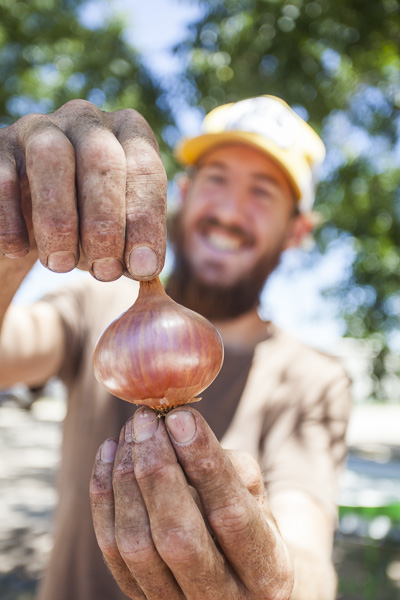 Montana and the onion. Photo by Scott David Gordon.
Montana and the onion. Photo by Scott David Gordon.
Onions hail from the Allium family... its members are often distinguished for having high sulfur compounds which contribute to their unique aroma and taste (sulfenic acid is what makes you cry when you cut into a fresh onion!). Leeks, garlic, scallions, shallots, and chives are some of the other veggie members of this perennial, flowering, and bulb-producing veggie fam. Despite the first paragraph’s talk of the onion’s omniscience throughout history, don’t be fooled, this crop is one of our more complicated vegetables to cultivate, and also one of our most important. Onions are one of our head farmer's favorites. He loves to tell the long and storied past of his travails with figuring out the cultivation of this bulb as it was so elusive to him for years, back when his farm fit in his backyard. He stumbled upon an onion mentor in the midst of his allium endeavors: Bruce “Onionman” Frasier, the head farmer of Dixondale Farms - one of the biggest producers of onions in the United States. Bruce really aided Brenton in his slow-learning onion education, and taught him one very important thing - the perfect onion has 13 rings.
“The size of an onion bulb is dependent upon the number and size of green leaves at the time of bulb maturity. For each leaf, there will be a ring of onion; the larger the leaf, the larger the ring will be. The perfect onion has 13 rings, which means that you should strive for 13 leaves if you want the biggest onions you've ever grown. The 9th leaf is usually the largest leaf on the plant, and that's when the nitrogen fertility should peak. When the 13th leaf appears, the onion is getting ready to start curing. This occurs at about the same time that the rest of the larger leaves have transferred most of their carbohydrates to the rings, so the onion's neck will start getting soft. It won't need as much moisture, which means you should stop irrigating the crop from this point on.” -Bruce Frasier, onion farmer extraordinaire.
Here at JBG, onions are started from seed in the bare ground. At the end of summer/fall, we prepare about 15 beds (want to learn more about the bed-making process? Click here!), plant onion seeds very tightly together, and let them grow for about 6 to 8 weeks. When they get to pencil-length thickness, we pull them out of the ground, yank the tops off (leaving a few inches of green), and move them to another plastic-covered bed. This is to allow them space to spread out, grow, and bulb. This transplanting process usually begins in October or November and takes about 5 or 6 weeks to complete as there are so many beds of onions, plus a massive amount of plant going into those beds! Onions are frost-resistant and massively resilient, so during the winter, they just hang onto the field until the days lengthen and spring sun returns. They really don’t start to grow until around early March, and when this time rolls around, the growth rate really starts to quicken.
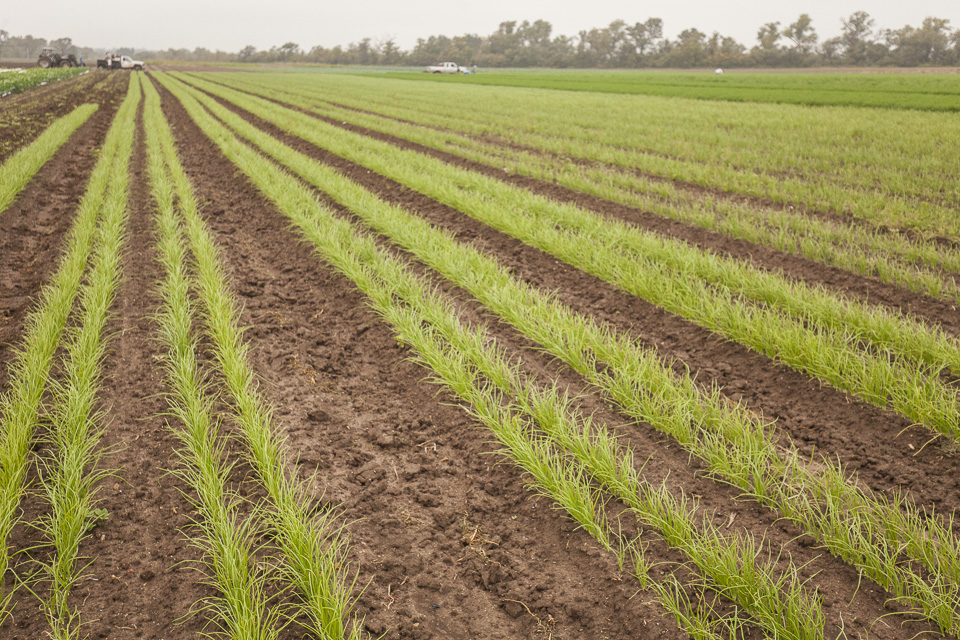 Bare ground growing of onions! Photo by Scott David Gordon.
Bare ground growing of onions! Photo by Scott David Gordon.
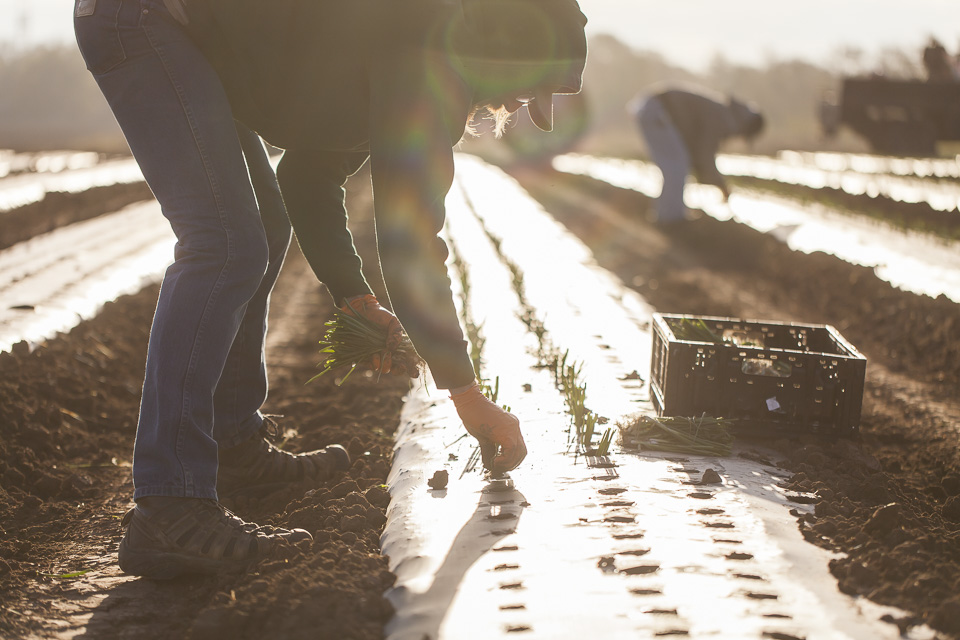 Transplanting onions. Photo by Scott David Gordon.
Transplanting onions. Photo by Scott David Gordon.
Fun fact: There three different kinds of onions - short-day (bulbing at 10-12 hours of sunlight), day-neutral (bulbing at 12-14 hours of sunlight), and long-day onions (bulbing at 14-16 hours of sunlight). Here in Austin, short-day onions thrive (we are on the verge of day-neutral, though!); thus, we focus on those. What triggers an onion to bulb is the number of hours of daylight it receives. They will only bulb if they get at least the amounts mentioned above. We plant short-day onions in the fall, while we plant the one day-neutral onion varietal we cultivate during the spring. The day length is why we plant at two different times, to make sure the length of light during a day will trigger bulbing. It’s really quite critical to plant onions at the right time of year to get the right amount of growth.
We don’t usually harvest the full bulb onions until around May. However, you might be wondering how to explain those green onions or spring onions you might be seeing at market? These are just tiny baby bulbs of the full-grown bulbs to come in later months. This allium is edible at every point of growth; thus, we harvest all throughout its lifecycle. It’s easy to differentiate green and spring onions because you can spot that spring onions have little baby bulbs, whereas green onions are long, skinny, and slender. We also grow multiplying onions, in late summer and fall to provide green onions during those times. These onions don’t ever form a bulb; however, when they become fully grown, they divide themselves. When you plant one, you’ll get a full chunk of them. These are also super resilient and hardy.
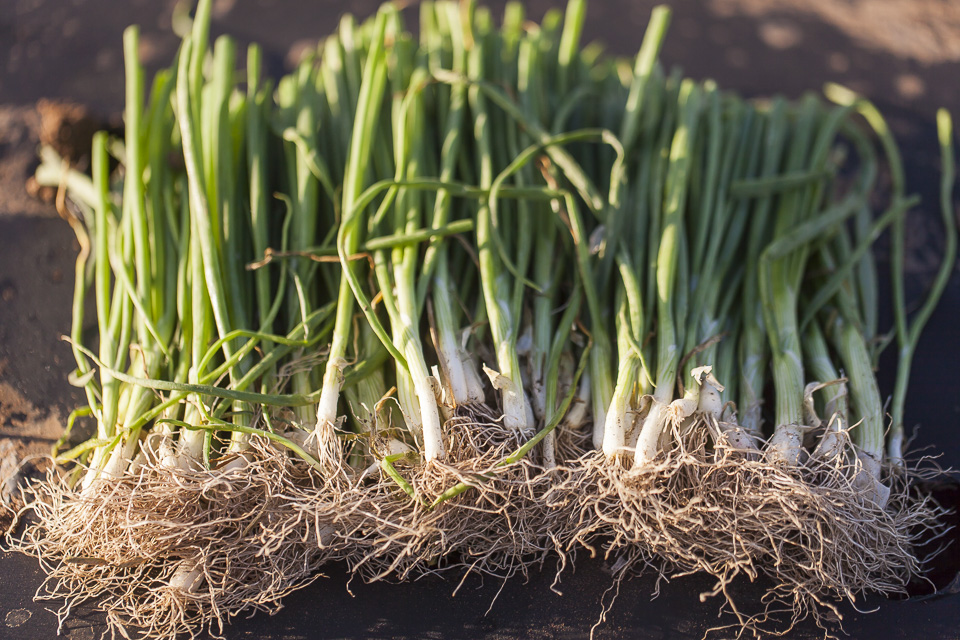 Green onions. Photo by Scott David Gordon.
Green onions. Photo by Scott David Gordon.
 Spring onions! Photo by Brenton.
Spring onions! Photo by Brenton.
When we harvest, we cut off the tops with a specialized tool, called onion shears, then cut the roots off of each bulb. We bag them up in 30 lb mesh bags and cure them in the greenhouse in high heat for a week. This removes the excess moisture and lengthens their longevity. Once they are good and papery on the outside, we lay them all out at the barn. We sic a leaf blower on them to remove dry excess skin and then pack them in bulk bins. We get them into cold storage, and they can last 4 to 5 months! Talk about storage crop!
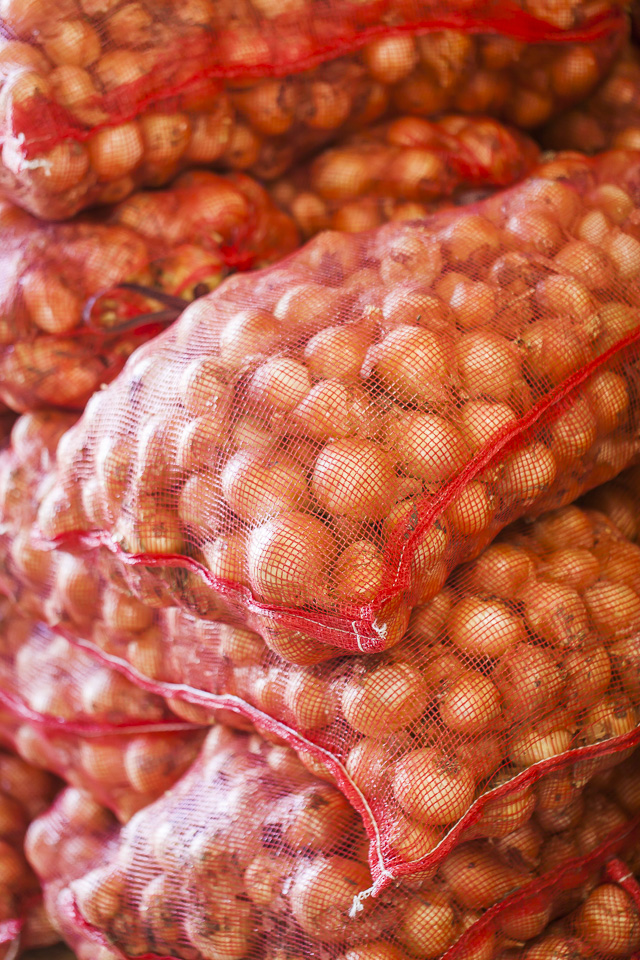 Curing in the greenhouse. Photo by Scott David Gordon.
Curing in the greenhouse. Photo by Scott David Gordon.
This year we are looking forward to a fruitful and long-lasting onion season! We have yellow, red, and white varieties that we are ecstatic to unveil to you in your CSA box and at market. Have fun(ion) out there in the SXSW fray! ‘Til next time.






 0 ITEMS IN CART
0 ITEMS IN CART 

